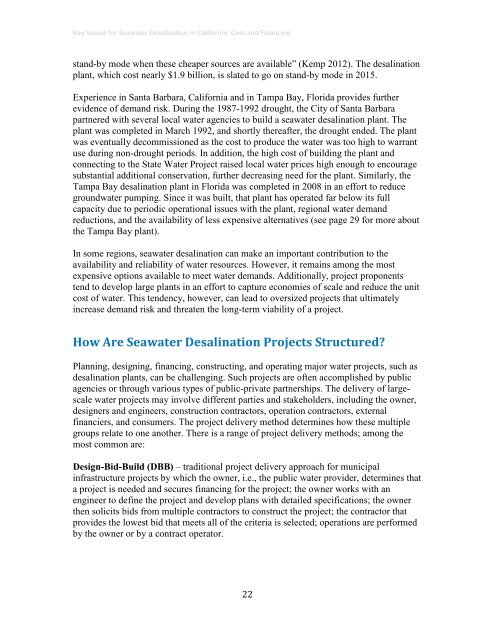997.4 KB - San Francisco Bay Area Independent Media Center
997.4 KB - San Francisco Bay Area Independent Media Center
997.4 KB - San Francisco Bay Area Independent Media Center
You also want an ePaper? Increase the reach of your titles
YUMPU automatically turns print PDFs into web optimized ePapers that Google loves.
Key Issues for Seawater Desalination in California: Cost and Financing<br />
stand-by mode when these cheaper sources are available” (Kemp 2012). The desalination<br />
plant, which cost nearly $1.9 billion, is slated to go on stand-by mode in 2015.<br />
Experience in <strong>San</strong>ta Barbara, California and in Tampa <strong>Bay</strong>, Florida provides further<br />
evidence of demand risk. During the 1987-1992 drought, the City of <strong>San</strong>ta Barbara<br />
partnered with several local water agencies to build a seawater desalination plant. The<br />
plant was completed in March 1992, and shortly thereafter, the drought ended. The plant<br />
was eventually decommissioned as the cost to produce the water was too high to warrant<br />
use during non-drought periods. In addition, the high cost of building the plant and<br />
connecting to the State Water Project raised local water prices high enough to encourage<br />
substantial additional conservation, further decreasing need for the plant. Similarly, the<br />
Tampa <strong>Bay</strong> desalination plant in Florida was completed in 2008 in an effort to reduce<br />
groundwater pumping. Since it was built, that plant has operated far below its full<br />
capacity due to periodic operational issues with the plant, regional water demand<br />
reductions, and the availability of less expensive alternatives (see page 29 for more about<br />
the Tampa <strong>Bay</strong> plant).<br />
In some regions, seawater desalination can make an important contribution to the<br />
availability and reliability of water resources. However, it remains among the most<br />
expensive options available to meet water demands. Additionally, project proponents<br />
tend to develop large plants in an effort to capture economies of scale and reduce the unit<br />
cost of water. This tendency, however, can lead to oversized projects that ultimately<br />
increase demand risk and threaten the long-term viability of a project.<br />
How Are Seawater Desalination Projects Structured?<br />
Planning, designing, financing, constructing, and operating major water projects, such as<br />
desalination plants, can be challenging. Such projects are often accomplished by public<br />
agencies or through various types of public-private partnerships. The delivery of largescale<br />
water projects may involve different parties and stakeholders, including the owner,<br />
designers and engineers, construction contractors, operation contractors, external<br />
financiers, and consumers. The project delivery method determines how these multiple<br />
groups relate to one another. There is a range of project delivery methods; among the<br />
most common are:<br />
Design-Bid-Build (DBB) – traditional project delivery approach for municipal<br />
infrastructure projects by which the owner, i.e., the public water provider, determines that<br />
a project is needed and secures financing for the project; the owner works with an<br />
engineer to define the project and develop plans with detailed specifications; the owner<br />
then solicits bids from multiple contractors to construct the project; the contractor that<br />
provides the lowest bid that meets all of the criteria is selected; operations are performed<br />
by the owner or by a contract operator.<br />
22
















